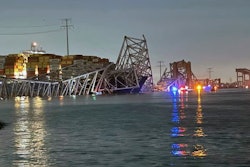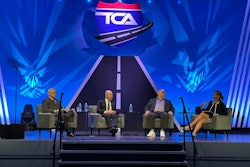 The North Central Texas Council of Governments is introducing the Freight Priority program, which aims to optimize traffic flow for trucks.North Central Texas Council of Governments
The North Central Texas Council of Governments is introducing the Freight Priority program, which aims to optimize traffic flow for trucks.North Central Texas Council of Governments
Freight North Texas, an ongoing planning program led by the North Central Texas Council of Governments (NCTCOG), is working to eliminate stops at traffic lights with an intelligent traffic signal optimization program that has been adapted from transit authority systems for trucks to enhance the safety, mobility, efficiency and air quality associated with freight movements in the Dallas-Fort Worth region.
Another statewide project, Texas Connected Freight Corridors, that received federal funding to provide traveler information to freight vehicles through connected vehicle technology for what’s known as The Triangle – I-35, I-45 and I-10 – found in a user survey that last-mile deliveries were still an issue: getting off the freeways and getting through traffic lights in the warehouse districts. That became the impetus for the Freight Priority project.
The Lone Star State placed 13 locations – the most of any single state – on the top 100 most congested bottlenecks for trucks in America list compiled annually by the American Transportation Research Institute. NCTCOG selected a team lead by planning and design consultants Kimley-Horn to conduct Freight Priority, a five-year program that identifies 500 traffic signals across metro DFW that would most benefit from freight-flow optimization.
“In north Texas, since it's the center of the U.S. for so many truck and freight routes, this is an ideal location to have a program begin like this,” said Leigh Hornsby, managing principal at Public Information Associates.
Kent Kacir, project manager at Kimley-Horn, said to his knowledge, this is the first program of its kind in the nation, and he thinks many other cities will follow suit. He said he anticipates that Garland and McKinney will be the first Texas cities to participate the program, which is expected to deploy in the next couple of months.
Freight Priority is a free service to truckers and fleets traveling through the area. The program uses an app or a truck’s telematics system to connect the vehicle to the cloud, where the GPS location of the vehicle is shared with the EcoDrive app and Smart Priority software and is disseminated to the signal priority system. It works with any high-resolution (1s-5s) automatic vehicle location (AVL) feed from a variety of third-party systems and can be used by freight operators without AVL by using the mobile or dash appliance app, which is still being developed. It does not require any additional hardware on the truck side or the city side.
“Once we know that a truck is within a particular area of an intersection that we have granted rights to control, then our signal goes down from the cloud to the local agency’s traffic signal to extend that phase an additional four or five seconds,” Kacir said.
He said the app will provide drivers with an optimized speed advisory, which is the recommended speed they should drive to be able to traverse a group of traffic lights on green. It will also let drivers know when the end of a green phase is coming so they can slow down.
The signal priority system can extend a green light and truncate a redlight so a truck can get through without making a stop, which costs time, fuel and emissions.

The program will track multiple metrics to discover the benefits; metrics that include fuel, time and greenhouse gas emissions savings. It will also include a safety assessment with a before and after study of crash data. The data will be anonymized but available to the public.
“We have in development as we speak a dashboard that will be available to anybody; it's public facing; they'll be able to go to the website and see exactly on a day-to-day basis what metrics are being saved in what community,” Kacir said. “Then, if you're a local agency operator – let's say the city of Garland – you will be able to go to it and, with special privileges, look into deeper details of your traffic management system and be able to pull out of that specific details on which signal actually gave the most benefit to the trucks.”
Though there is no way to track it on a per-truck basis, but the program estimates that the signal priority system will save 16,000 hours of travel time for truckers, $400,000 in fuel and operational costs for fleet operators and 325 metric tons of emissions.
Local governments can register as a user on FreightPriority.com. Hornsby said the program is looking for additional participants on the freight side, especially owner operators who travel through the area.
“One of the things we were hoping from our outreach here is to connect and have a wider swath of people that we might be able to let them know about the program,” she said. “There are so many independent operators out there, too, who are welcome to participate in this as well. We're really focusing on opportunities for identifying and reaching out to potential participants.”












